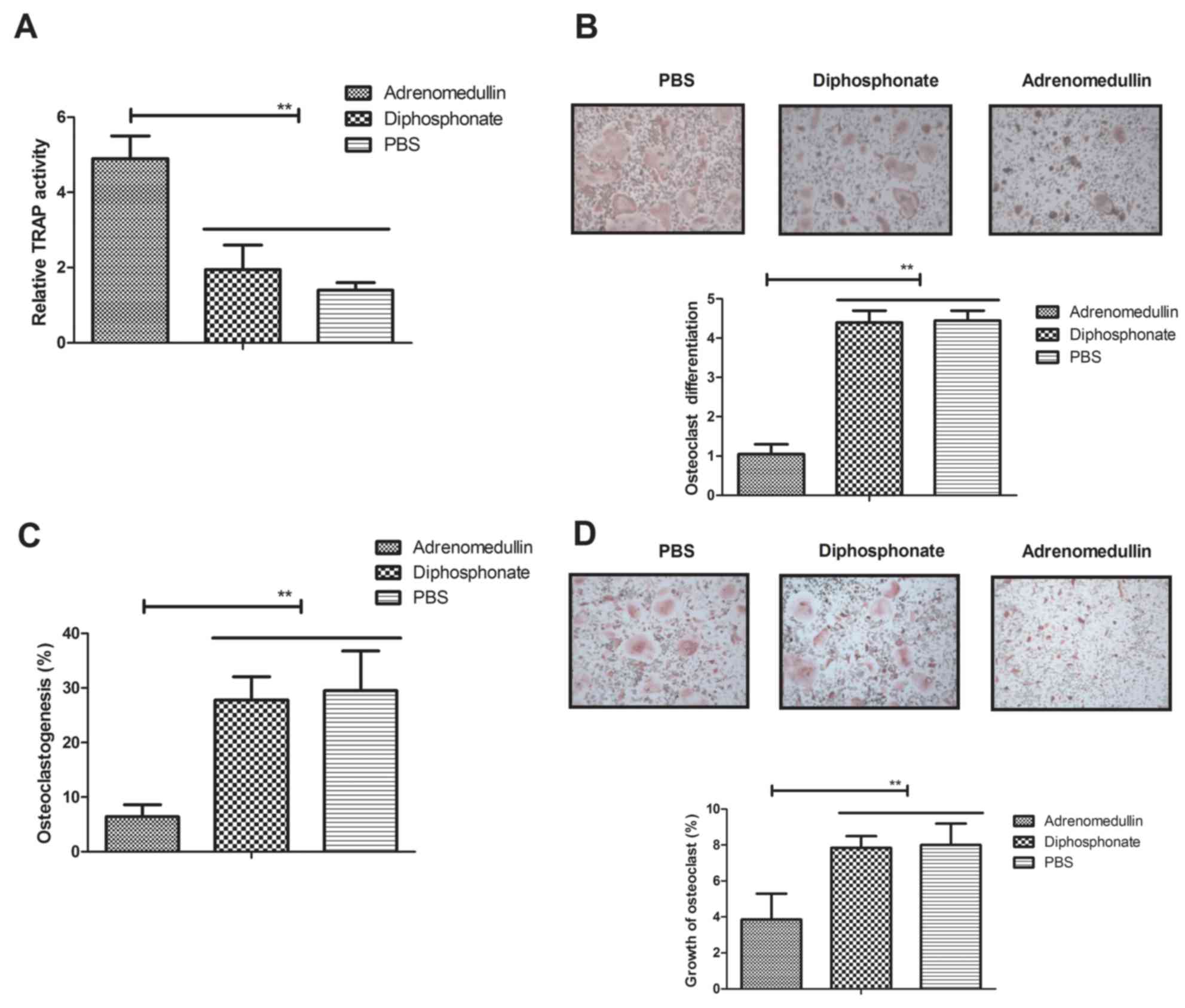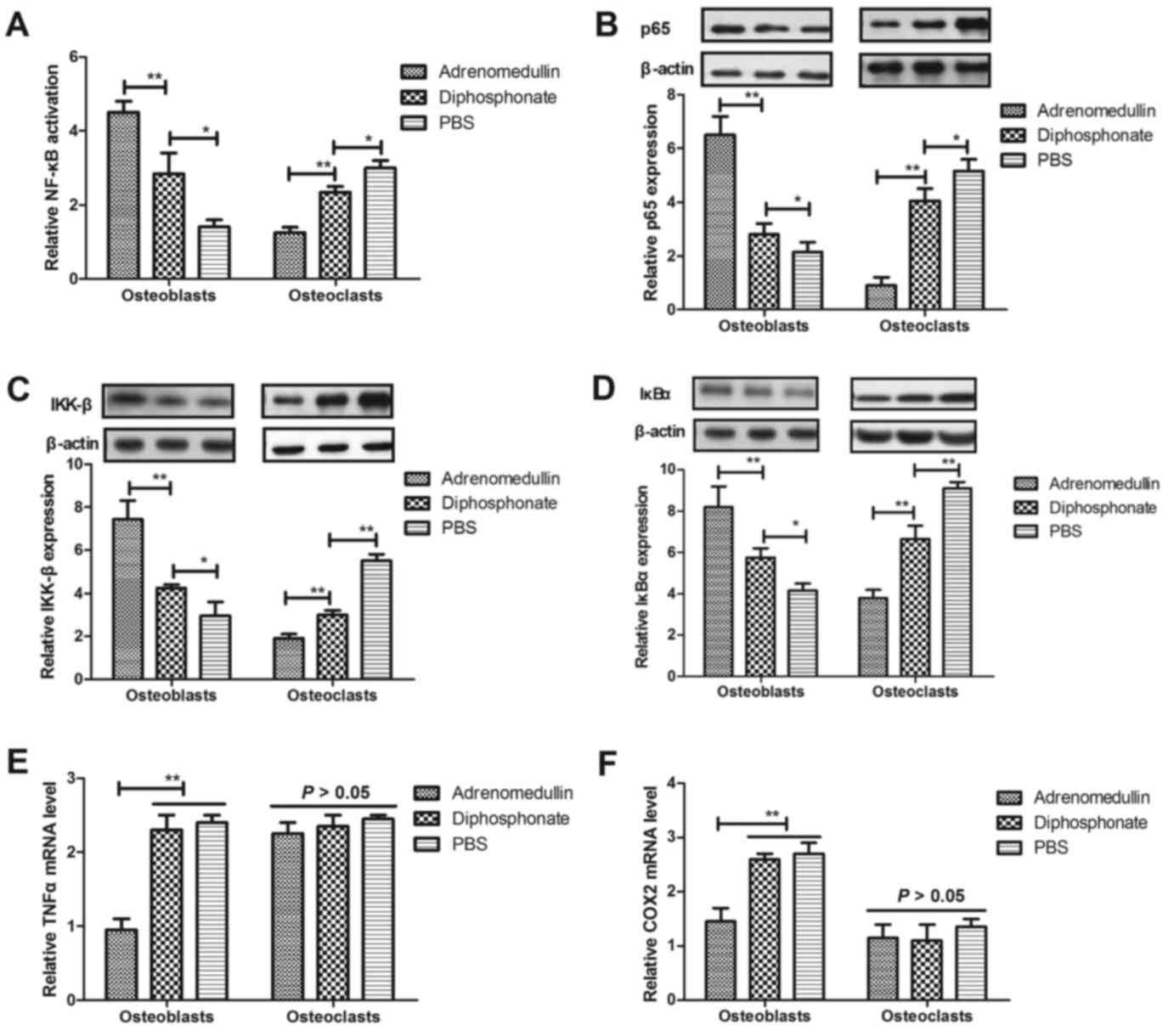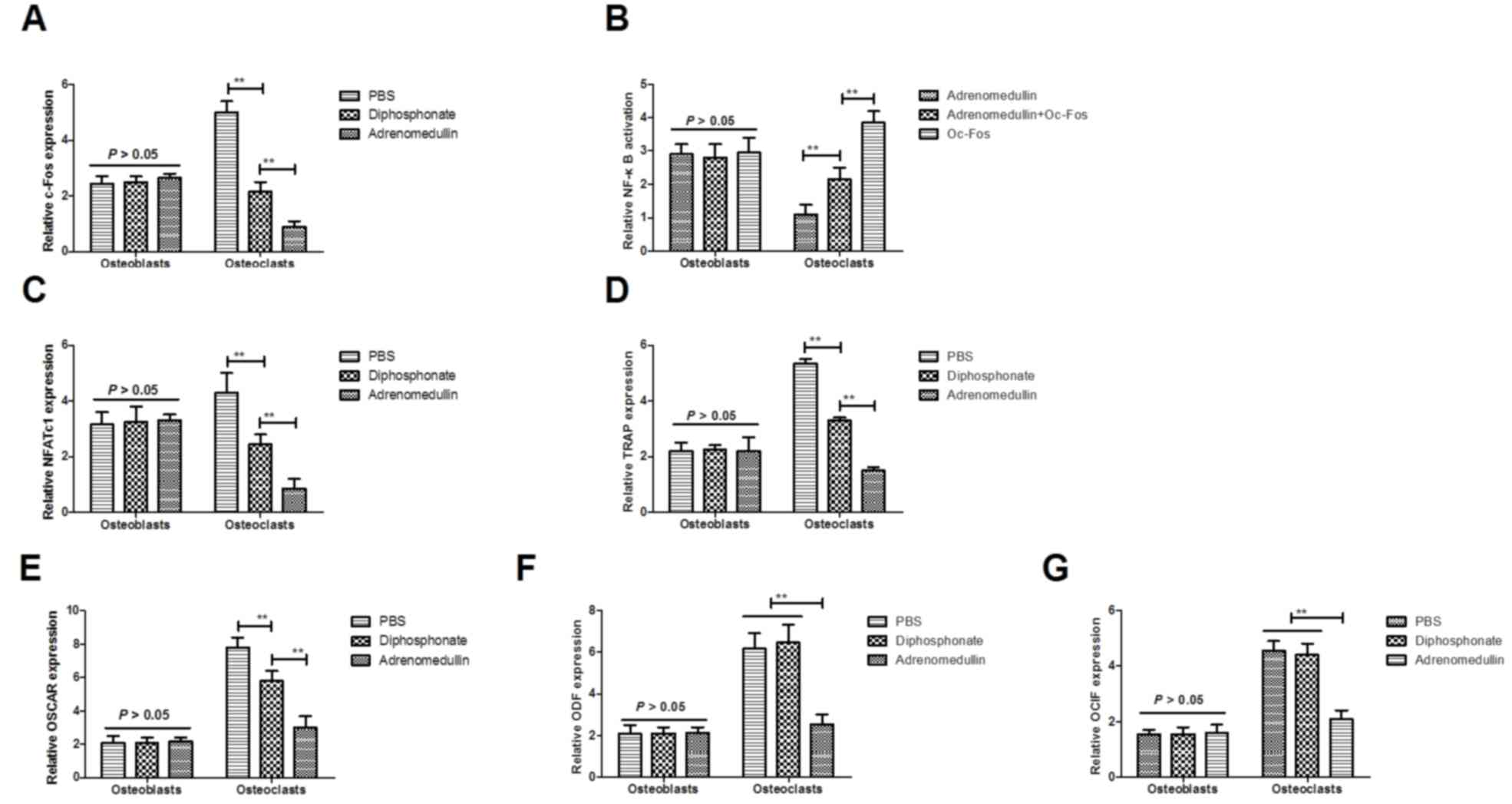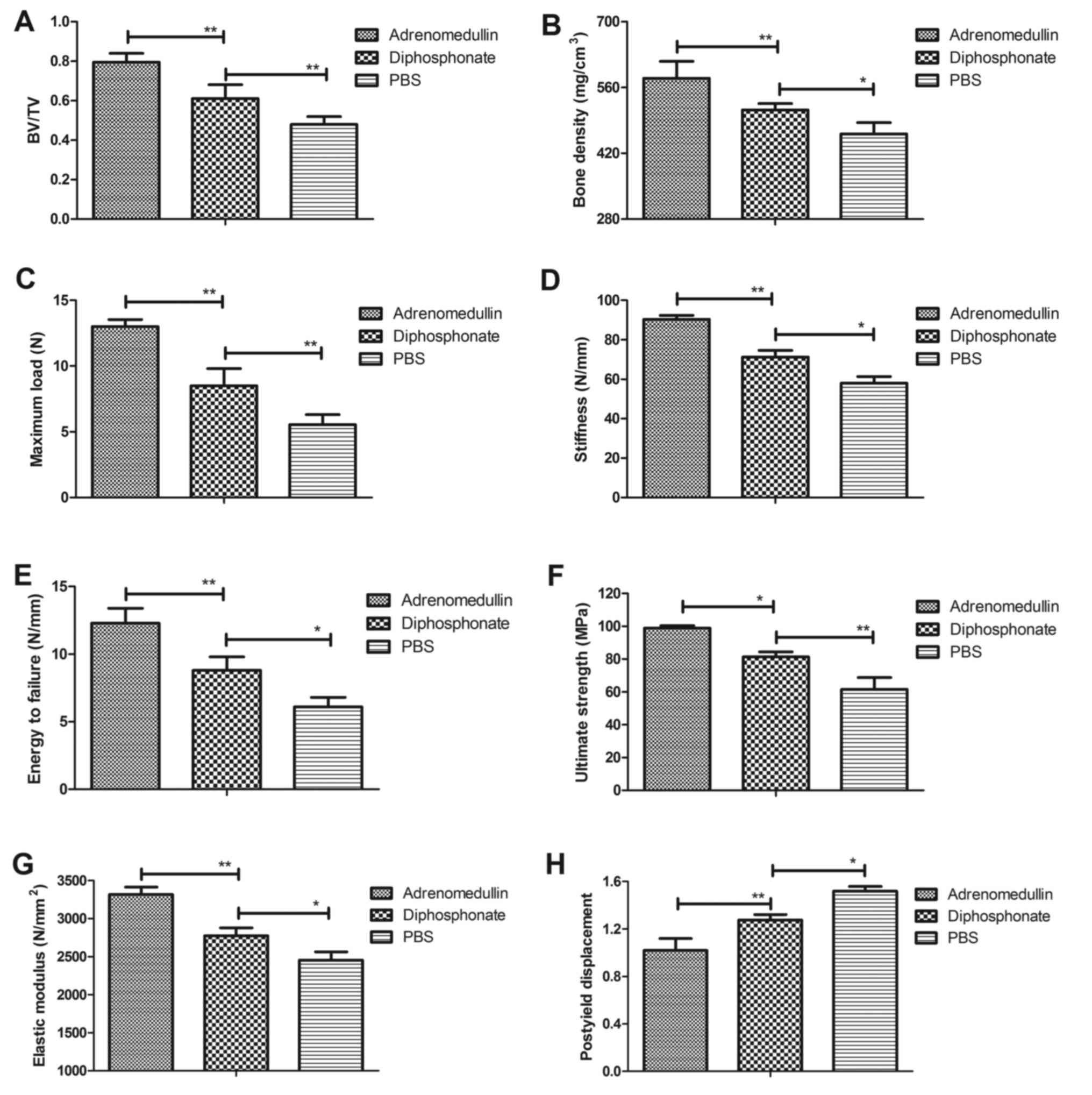|
1
|
An G, Acharya C, Feng X, Wen K, Zhong M,
Zhang L, Munshi NC, Qiu L, Tai YT and Anderson KC: Osteoclasts
promote immune suppressive microenvironment in multiple myeloma:
Therapeutic implication. Blood. 128:1590–1603. 2016. View Article : Google Scholar : PubMed/NCBI
|
|
2
|
Kim TH, Park EK, Huh MI, Kim HK, Kim SY
and Lee SH: Rhus javanica gall extract inhibits the differentiation
of bone marrow-derived osteoclasts and ovariectomy-induced bone
loss. Evid Based Complement Alternat Med. 2016:32847042016.
View Article : Google Scholar : PubMed/NCBI
|
|
3
|
Jeon OH, Panicker LM, Lu Q, Chae JJ,
Feldman RA and Elisseeff JH: Human iPSC-derived osteoblasts and
osteoclasts together promote bone regeneration in 3D biomaterials.
Sci Rep. 6:267612016. View Article : Google Scholar : PubMed/NCBI
|
|
4
|
Paglia DN, Yang X, Kalinowski J,
Jastrzebski S, Drissi H and Lorenzo J: Runx1 regulates myeloid
precursor differentiation into osteoclasts without affecting
differentiation into antigen presenting or phagocytic cells in both
males and females. Endocrinology. 157:3058–3069. 2016. View Article : Google Scholar : PubMed/NCBI
|
|
5
|
Laperine O, Blin-Wakkach C, Guicheux J,
Beck-Cormier S and Lesclous P: Dendritic-cell-derived osteoclasts:
A new game changer in bone-resorption-associated diseases. Drug
Discov Today. 21:1345–1354. 2016. View Article : Google Scholar : PubMed/NCBI
|
|
6
|
Scott LJ: Denosumab: A review of its use
in postmenopausal women with osteoporosis. Drugs Aging. 31:555–576.
2014. View Article : Google Scholar : PubMed/NCBI
|
|
7
|
Yu S, Liu F, Cheng Z and Wang Q:
Association between osteoporosis and benign paroxysmal positional
vertigo: A systematic review. BMC Neurol. 14:1102014. View Article : Google Scholar : PubMed/NCBI
|
|
8
|
Henriksen K, Bollerslev J, Everts V and
Karsdal MA: Osteoclast activity and subtypes as a function of
physiology and pathology-implications for future treatments of
osteoporosis. Endocr Rev. 32:31–63. 2011. View Article : Google Scholar : PubMed/NCBI
|
|
9
|
Ghosh M and Majumdar SR: Antihypertensive
medications, bone mineral density and fractures: A review of old
cardiac drugs that provides new insights into osteoporosis.
Endocrine. 46:397–405. 2014. View Article : Google Scholar : PubMed/NCBI
|
|
10
|
Iesato Y, Yuda K, Chong KT, Tan X, Murata
T, Shindo T and Yanagi Y: Adrenomedullin: A potential therapeutic
target for retinochoroidal disease. Prog Retin Eye Res. 52:112–129.
2016. View Article : Google Scholar : PubMed/NCBI
|
|
11
|
DE LA, Torre-Prados MV, Garcia-DE LA,
Torre A, Enguix A, Mayor-Reyes M, Nieto-González M and
Garcia-Alcantara A: Mid-regional pro-adrenomedullin as prognostic
biomarker in septic shock. Minerva Anestesiol. 82:760–766.
2016.PubMed/NCBI
|
|
12
|
Hu W, Zhou PH, Rao T, Zhang XB, Wang W and
Zhang LJ: Adrenomedullin attenuates interleukin-1β-induced
inflammation and apoptosis in rat Leydig cells via inhibition of
NF-κB signaling pathway. Exp Cell Res. 339:220–230. 2015.
View Article : Google Scholar : PubMed/NCBI
|
|
13
|
Kim JH, Kim K, Kim I, Seong S, Nam KI, Lee
SH, Kim KK and Kim N: Role of CrkII signaling in RANKL-induced
osteoclast differentiation and function. J Immunol. 196:1123–1131.
2016. View Article : Google Scholar : PubMed/NCBI
|
|
14
|
Ito S, Ohmi A, Sakamiya A, Yano T, Okumura
K, Nishimura N and Kagontani K: Ginger hexane extract suppresses
RANKL-induced osteoclast differentiation. Biosci Biotechnol
Biochem. 80:779–785. 2016. View Article : Google Scholar : PubMed/NCBI
|
|
15
|
Qian H, Yuan H, Wang J, Du Y, Zhang X, Sun
Y, Li Z and Zhao W: A monoclonal antibody ameliorates local
inflammation and osteoporosis by targeting TNF-α and RANKL. Int
Immunopharmacol. 20:370–376. 2014. View Article : Google Scholar : PubMed/NCBI
|
|
16
|
Lakhan R, Baylink DJ, Lau KH, Tang X,
Sheng MH, Rundle CH and Qin X: Local administration of AAV-DJ
pseudoserotype expressing COX2 provided early onset of transgene
expression and promoted bone fracture healing in mice. Gene Ther.
22:721–728. 2015. View Article : Google Scholar : PubMed/NCBI
|
|
17
|
Arrabal-Polo MA, Girón-Prieto MS,
Cano-García Mdel C, Poyatos-Andujar A, Quesada-Charneco M,
Abad-Menor F, Arias-Santiago S, Zuluaga-Gomez A and Arrabal-Martin
M: Retrospective review of serum and urinary lithogenic risk
factors in patients with osteoporosis and osteopenia. Urology.
85:782–785. 2015. View Article : Google Scholar : PubMed/NCBI
|
|
18
|
Chiu CK, Kuo MC, Yu SF, Su BY and Cheng
TT: Adherence to osteoporosis regimens among men and analysis of
risk factors of poor compliance: A 2-year analytical review. BMC
Musculoskelet Disord. 14:2762013. View Article : Google Scholar : PubMed/NCBI
|
|
19
|
Srikanth R, Cassidy G, Joiner C and
Teeluckdharry S: Osteoporosis in people with intellectual
disabilities: A review and a brief study of risk factors for
osteoporosis in a community sample of people with intellectual
disabilities. J Intellect Disabil Res. 55:53–62. 2011. View Article : Google Scholar : PubMed/NCBI
|
|
20
|
Papamanthos M, Varitimidis S, Dailiana Zh,
Kogia E and Malizos K: Computer-assisted evaluation of Mandibular
Cortical Width (MCW) index as an indicator of osteoporosis.
Hippokratia. 18:251–257. 2014.PubMed/NCBI
|
|
21
|
Schwarz P: Diphosphonate treatment of
osteoporosis and risk of atypical femoral fractures. Ugeskr Laeger.
174:302012.(In Danish). PubMed/NCBI
|
|
22
|
Kushwaha P, Khedgikar V, Ahmad N, Karvande
A, Gautam J, Kumar P, Maurya R and Trivedi R: A neoflavonoid
dalsissooal isolated from heartwood of Dalbergia sissoo Roxb. Has
bone forming effects in mice model for osteoporosis. Eur J
Pharmacol. 788:65–74. 2016. View Article : Google Scholar : PubMed/NCBI
|
|
23
|
Shum LC, White NS, Nadtochiy SM, Bentley
KL, Brookes PS, Jonason JH and Eliseev RA: Cyclophilin D Knock-Out
mice show enhanced resistance to osteoporosis and to metabolic
changes observed in aging bone. PLoS One. 11:e01557092016.
View Article : Google Scholar : PubMed/NCBI
|
|
24
|
Penolazzi L, Lolli A, Sardelli L,
Angelozzi M, Lambertini E, Trombelli L, Ciarpella F, Vecchiatini R
and Piva R: Establishment of a 3D-dynamic osteoblasts-osteoclasts
co-culture model to simulate the jawbone microenvironment in vitro.
Life Sci. 152:82–93. 2016. View Article : Google Scholar : PubMed/NCBI
|
|
25
|
Baltacioglu E, Kehribar MA, Yuva P, Alver
A, Atagün OS, Karabulut E and Akalın FA: Total oxidant status and
bone resorption biomarkers in serum and gingival crevicular fluid
of patients with periodontitis. J Periodontol. 85:317–326. 2014.
View Article : Google Scholar : PubMed/NCBI
|
|
26
|
Ishihara A, Helbig HJ, Sanchez-Hodge RB,
Wellman ML, Landrigan MD and Bertone AL: Performance of a
gravitational marrow separator, multidirectional bone marrow
aspiration needle, and repeated bone marrow collections on the
production of concentrated bone marrow and separation of
mesenchymal stem cells in horses. Am J Vet Res 74: 854–863, 2013.
Am J Vet Res. 74:854–863. 2013. View Article : Google Scholar : PubMed/NCBI
|
|
27
|
Xiao S, Wang J and Xiao N: MicroRNAs as
noninvasive biomarkers in bladder cancer detection: A diagnostic
meta-analysis based on qRT-PCR data. Int J Biol Markers.
31:e276–e285. 2016. View Article : Google Scholar : PubMed/NCBI
|
|
28
|
Lisi S, Sisto M, Lofrumento DD and D'Amore
M: Sjögren's syndrome autoantibodies provoke changes in gene
expression profiles of inflammatory cytokines triggering a pathway
involving TACE/NF-κB. Lab Invest. 92:615–624. 2012. View Article : Google Scholar : PubMed/NCBI
|
|
29
|
Shiraishi T, Fukuda K, Morotomi N, Imamura
Y, Mishima J, Imai S, Miyazawa K and Taniguchi H: Influence of
menstruation on the microbiota of healthy women's labia minora as
analyzed using a 16S rRNA gene-based clone library method. Jpn J
Infect Dis. 64:76–80. 2011.PubMed/NCBI
|
|
30
|
Wai-Hoe L, Wing-Seng L, Ismail Z and
Lay-Harn G: SDS-PAGE-based quantitative assay for screening of
kidney stone disease. Biol Proced Online. 11:145–160. 2009.
View Article : Google Scholar : PubMed/NCBI
|
|
31
|
Pengjam Y, Madhyastha H, Madhyastha R,
Yamaguchi Y, Nakajima Y and Maruyama M: NF-κB pathway inhibition by
anthrocyclic glycoside aloin is key event in preventing
osteoclastogenesis in RAW264.7 cells. Phytomedicine. 23:417–428.
2016. View Article : Google Scholar : PubMed/NCBI
|
|
32
|
Kwak HB, Lee BK, Oh J, Yeon JT, Choi SW,
Cho HJ, Lee MS, Kim JJ, Bae JM, Kim SH and Kim HS: Inhibition of
osteoclast differentiation and bone resorption by rotenone, through
down-regulation of RANKL-induced c-Fos and NFATc1 expression. Bone.
46:724–731. 2010. View Article : Google Scholar : PubMed/NCBI
|
|
33
|
Lee CH, Kwak SC, Kim JY, Oh HM, Rho MC,
Yoon KH, Yoo WH, Lee MS and Oh J: Genipin inhibits RANKL-induced
osteoclast differentiation through proteasome-mediated degradation
of c-Fos protein and suppression of NF-κB activation. J Pharmacol
Sci. 124:344–353. 2014. View Article : Google Scholar : PubMed/NCBI
|
|
34
|
Lee EG, Sung MS, Yoo HG, Chae HJ, Kim HR
and Yoo WH: Increased RANKL-mediated osteoclastogenesis by
interleukin-1β and endoplasmic reticulum stress. Joint Bone Spine.
81:520–526. 2014. View Article : Google Scholar : PubMed/NCBI
|
|
35
|
Lee SY, Lee KS, Yi SH, Kook SH and Lee JC:
Acteoside suppresses RANKL-mediated osteoclastogenesis by
inhibiting c-Fos induction and NF-κB pathway and attenuating ROS
production. PLoS One. 8:e808732013. View Article : Google Scholar : PubMed/NCBI
|
|
36
|
Yun HJ, Lee EG, Lee SI, Chae HJ and Yoo
WH: Adrenomedullin inhibits MAPK pathway-dependent rheumatoid
synovial fibroblast-mediated osteoclastogenesis by IL-1 and
TNF-alpha. Rheumatol Int. 29:1161–1168. 2009. View Article : Google Scholar : PubMed/NCBI
|
|
37
|
Martinez-Herrero S, Larrayoz IM,
Ochoa-Callejero L, Fernández LJ, Allueva A, Ochoa I and Martínez A:
Prevention of bone loss in a model of postmenopausal osteoporosis
through adrenomedullin inhibition. Front Physiol. 7:2802016.
View Article : Google Scholar : PubMed/NCBI
|
|
38
|
Lin J, Lu C and Gao L: Study on the level
of plasma calcitonin gene-related peptide and adrenomedullin in
subjects with primary osteoporosis. Zhonghua Yi Xue Za Zhi.
81:841–843. 2001.(In Chinese). PubMed/NCBI
|
|
39
|
Prause M, Seeliger C, Unger M, Balmayor
Rosado E, van Griensven M and Haug AT: Pantoprazole decreases cell
viability and function of human osteoclasts in vitro. Mediators
Inflamm. 2015:4130972015. View Article : Google Scholar : PubMed/NCBI
|
|
40
|
Touaitahuata H, Cres G, de Rossi S, Vives
V and Blangy A: The mineral dissolution function of osteoclasts is
dispensable for hypertrophic cartilage degradation during long bone
development and growth. Dev Biol. 393:57–70. 2014. View Article : Google Scholar : PubMed/NCBI
|
|
41
|
Wu C, Zhang J and Tian J: Research
progress of osteoclasts function beyond bone resorption. Zhongguo
Xiu Fu Chong Jian Wai Ke Za Zhi. 29:1038–1042. 2015.(In Chinese).
PubMed/NCBI
|
|
42
|
Yang C, Madhu V, Thomas C, Yang X, Du X,
Dighe AS and Cui Q: Inhibition of differentiation and function of
osteoclasts by dimethyl sulfoxide (DMSO). Cell Tissue Res.
362:577–585. 2015. View Article : Google Scholar : PubMed/NCBI
|
|
43
|
Takami M: Differentiation and function of
osteoclasts. Nihon Rinsho. 69:1170–1173. 2011.(In Japanese).
PubMed/NCBI
|
|
44
|
Reyes JP, Sims SM and Dixon SJ: P2
receptor expression, signaling and function in osteoclasts. Front
Biosci (Schol Ed). 3:1101–1118. 2011. View
Article : Google Scholar : PubMed/NCBI
|
|
45
|
Agrawal A, Buckley KA, Bowers K, Furber M,
Gallagher JA and Gartland A: The effects of P2X7 receptor
antagonists on the formation and function of human osteoclasts in
vitro. Purinergic Signal. 6:307–315. 2010. View Article : Google Scholar : PubMed/NCBI
|
|
46
|
Li H, Hong S, Qian J, Zheng Y, Yang J and
Yi Q: Cross talk between the bone and immune systems: Osteoclasts
function as antigen-presenting cells and activate CD4+ and CD8+ T
cells. Blood. 116:210–217. 2010. View Article : Google Scholar : PubMed/NCBI
|
|
47
|
Imai Y, Youn MY, Kondoh S, Nakamura T,
Kouzmenko A, Matsumoto T, Takada I, Takaoka K and Kato S: Estrogens
maintain bone mass by regulating expression of genes controlling
function and life span in mature osteoclasts. Ann N Y Acad Sci.
1173 Suppl 1:E31–E39. 2009. View Article : Google Scholar : PubMed/NCBI
|
|
48
|
Witten PE and Huysseune A: A comparative
view on mechanisms and functions of skeletal remodelling in teleost
fish, with special emphasis on osteoclasts and their function. Biol
Rev Camb Philos Soc. 84:315–346. 2009. View Article : Google Scholar : PubMed/NCBI
|
|
49
|
Dai X, Ma W, Jha RK and He X:
Adrenomedullin and its expression in cancers and bone. A literature
review. Front Biosci (Elite Ed). 2:1073–1080. 2010.PubMed/NCBI
|
|
50
|
Iwase T, Nagaya N, Fujii T, Itoh T,
Ishibashi-Ueda H, Yamagishi M, Miyatake K, Matsumoto T, Kitamura S
and Kangawa K: Adrenomedullin enhances angiogenic potency of bone
marrow transplantation in a rat model of hindlimb ischemia.
Circulation. 111:356–362. 2005. View Article : Google Scholar : PubMed/NCBI
|
|
51
|
Pleguezuelos O, Hagi-Pavli E, Crowther G
and Kapas S: Adrenomedullin signals through NF-kappaB in epithelial
cells. FEBS Lett. 577:249–254. 2004. View Article : Google Scholar : PubMed/NCBI
|
|
52
|
Yang J, Wang W, Dong M, Yu X and Luo Q:
Effect of nucleoprotein factor-kB (NF-κB) in endothelial cells
during high blood flow-associated pulmonary vascular remodeling on
vasoactive substances adrenomedullin and prostacyclin. Int J Clin
Exp Med. 8:13842–13847. 2015.PubMed/NCBI
|
|
53
|
Lee CH, Jeon YT, Kim SH and Song YS:
NF-kappaB as a potential molecular target for cancer therapy.
Biofactors. 29:19–35. 2007. View Article : Google Scholar : PubMed/NCBI
|


















